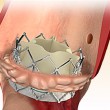Tricuspid regurgitation (TR) has been associated with worse survival and hospitalization for cardiac failure (CF). The current guidelines recommend surgery as treatment, despite its 8 – 15% 30-day mortality rate. And there is no mention of a transcatheter intervention, especially for patients with severe TR and right ventricular deterioration. Several percutaneous intervention devices have recently<a href="https://solaci.org/en/2024/07/12/edge-to-edge-repair-for-right-ventricular-function-deterioration/" title="Read more" >...</a>
2 Year Outcomes of Transcatheter Mitral Valve Replacement with Intrepid
Severe mitral valve insufficiency (MI) has been associated to the progressive deterioration of left ventricular function, cardiac and kidney failure, and increased mortality. Complete medical treatment at maximal doses and surgery are indicated. For those at high risk or those with ventricular function deterioration, edge-to-edge repair has been shown an excellent alternative. The use of<a href="https://solaci.org/en/2024/07/02/2-year-outcomes-of-transcatheter-mitral-valve-replacement-with-intrepid/" title="Read more" >...</a>
Microvascular Resistant Reserve: Impact on STEMI Patients
Coronary Microvascular Dysfunction (CMD) is being increasingly considered a common consequence of STEMI. Its presence partly explains the persistence of angina symptoms in over 50% of patients after PCI, despite successful epicardial artery reperfusion. Also, CMD has been independently associated with worse left ventricular ejection fraction recovery, which leads to worse prognosis, including recurrent events,<a href="https://solaci.org/en/2024/05/29/microvascular-resistant-reserve-impact-on-stemi-patients/" title="Read more" >...</a>
Third Generation Balloon-Expandable and Self-Expanding Valves: TAVR Meta- Analysis
TAVR’s significant advance has driven the development of valve technology, which is currently in its third generation. Even though outcomes have improved, randomized studies are yet to compared balloon-expandable (BEV) vs self-expanding (SEV) valves in randomized studies, and we only have information from different analysis with contradicting conclusions. This was a meta-analysis of 16 studies<a href="https://solaci.org/en/2024/05/24/third-generation-balloon-expandable-and-self-expanding-valves-tavr-meta-analysis/" title="Read more" >...</a>
EuroPCR 2024 | Complete revascularization affects clinical outcomes? REVIVED.BCIS2 Insights
Complete revascularization has shown in several studies and meta-analysis a benefit in mortality vs. incomplete revascularization. The REVIVED-BCIS looked at whether there were differences in mortality and hospitalization for cardiac failure in patients with ventricular function deterioration and viability when comparing coronary angioplasty(PCI) against optimal medical treatment. This study showed that PCI was not associated<a href="https://solaci.org/en/2024/05/17/europcr-2024-complete-revascularization-affects-clinical-outcomes-revived-bcis2-insights/" title="Read more" >...</a>
EuroPCR 2024 | NOTION-2: TAVI vs SAVR, Randomized Study on Low-Risk Young Patients with Severe Tricuspid Disease or Bicuspid Stenosis
Many of the studies comparing TAVR against SAVR in low risk patients included patients between 70-75 years, excluding those with tricuspid valves. This study included low surgical risk patients with severe aortic stenosis and symptoms, 75 years or younger. Participants were randomized 1:1 to receiving TAVR or SAVR, stratified according to sex, need for new<a href="https://solaci.org/en/2024/05/17/europcr-2024-notion-2-tavi-vs-savr-randomized-study-on-low-risk-young-patients-with-severe-tricuspid-disease-or-bicuspid-stenosis/" title="Read more" >...</a>
EuroPCR 2024 | OBSERVANT II: TAVR in the “Real World”
This study analyzed 2,493 “real world” patients, 1,352 receiving the Evolut R/Pro, 675 the SAPIEN, 3,270 the Acurate Neo and 192 the Portico. Primary end point was all cause mortality and major adverse cardiovascular events (MACE) at 5 years. Populations were similar, with EuroSCORE 4.9%, and there were no significant differences in comorbidities or echocardiographic<a href="https://solaci.org/en/2024/05/15/europcr-2024-observant-ii-tavr-in-the-real-world/" title="Read more" >...</a>
Aortic Stenosis Progression Evolution
Aortic stenosis is an increasingly common valvulopathy because people are living longer now. A present, the main treatment consists of surgical (SAVR) or transcatheter aortic valve replacement. (TAVR). One of the main challenges of this disease is its progression. The European guidelines recommend Doppler echocardiograms every 2 to 3 years for mild cases, mildly calcified,<a href="https://solaci.org/en/2024/05/15/aortic-stenosis-progression-evolution/" title="Read more" >...</a>
Catheter-Based Therapy for Pulmonary Embolism: Lower Mortality and Rehospitalization?
Venous thromboembolism represents one of the main causes of cardiovascular death. Pulmonary embolism (PE) can vary from asymptomatic to manifesting with shock and sudden death, with a wide clinical spectrum. Patient followup is crucial, seeing as survival PE patients usually experience residual symptoms at long term, such as dyspnea or functional capacity deterioration. For decades,<a href="https://solaci.org/en/2024/05/13/catheter-based-therapy-for-pulmonary-embolism-lower-mortality-and-rehospitalization/" title="Read more" >...</a>
12-Month Evolution of Edge-to-Edge Repair with PASCAL
Mitral regurgitation (MR) is the most frequent valve disease. Mitral transcatheter edge-to-edge repair (M-TEER) has been shown beneficial in high or prohibitive risk patients in cases of degenerative and functional MR. The PASCAL device has been shown safe and effective by the CLASP II, but we still need further research in clinical “real world” environments. <a href="https://solaci.org/en/2024/05/02/12-month-evolution-of-edge-to-edge-repair-with-pascal/" title="Read more" >...</a>







